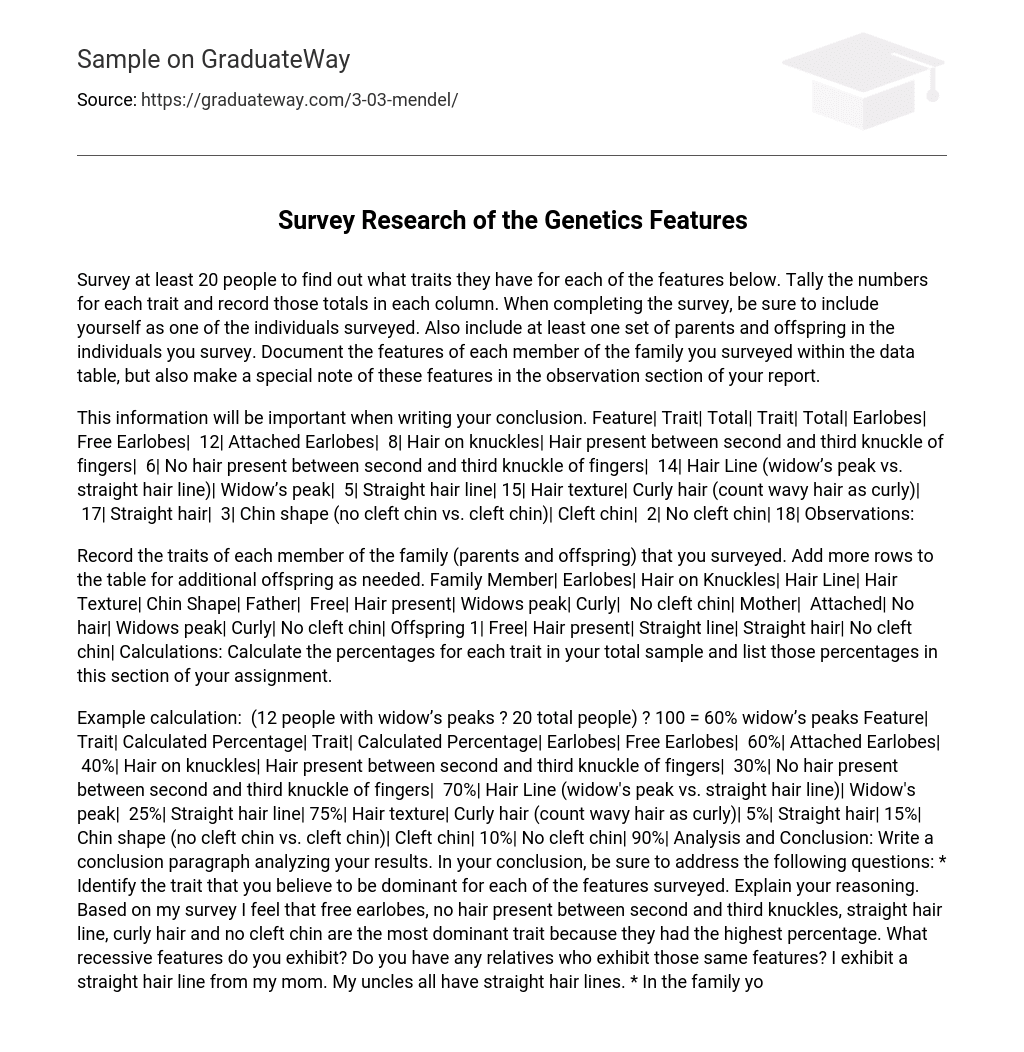Survey at least 20 people to find out what traits they have for each of the features below. Tally the numbers for each trait and record those totals in each column. When completing the survey, be sure to include yourself as one of the individuals surveyed. Also include at least one set of parents and offspring in the individuals you survey. Document the features of each member of the family you surveyed within the data table, but also make a special note of these features in the observation section of your report.
This information will be important when writing your conclusion. Feature| Trait| Total| Trait| Total| Earlobes| Free Earlobes| 12| Attached Earlobes| 8| Hair on knuckles| Hair present between second and third knuckle of fingers| 6| No hair present between second and third knuckle of fingers| 14| Hair Line (widow’s peak vs. straight hair line)| Widow’s peak| 5| Straight hair line| 15| Hair texture| Curly hair (count wavy hair as curly)| 17| Straight hair| 3| Chin shape (no cleft chin vs. cleft chin)| Cleft chin| 2| No cleft chin| 18| Observations:
Record the traits of each member of the family (parents and offspring) that you surveyed. Add more rows to the table for additional offspring as needed. Family Member| Earlobes| Hair on Knuckles| Hair Line| Hair Texture| Chin Shape| Father| Free| Hair present| Widows peak| Curly| No cleft chin| Mother| Attached| No hair| Widows peak| Curly| No cleft chin| Offspring 1| Free| Hair present| Straight line| Straight hair| No cleft chin| Calculations: Calculate the percentages for each trait in your total sample and list those percentages in this section of your assignment.
Example calculation: (12 people with widow’s peaks ? 20 total people) ? 100 = 60% widow’s peaks Feature| Trait| Calculated Percentage| Trait| Calculated Percentage| Earlobes| Free Earlobes| 60%| Attached Earlobes| 40%| Hair on knuckles| Hair present between second and third knuckle of fingers| 30%| No hair present between second and third knuckle of fingers| 70%| Hair Line (widow’s peak vs. straight hair line)| Widow’s peak| 25%| Straight hair line| 75%| Hair texture| Curly hair (count wavy hair as curly)| 5%| Straight hair| 15%| Chin shape (no cleft chin vs. cleft chin)| Cleft chin| 10%| No cleft chin| 90%| Analysis and Conclusion: Write a conclusion paragraph analyzing your results. In your conclusion, be sure to address the following questions: * Identify the trait that you believe to be dominant for each of the features surveyed. Explain your reasoning. Based on my survey I feel that free earlobes, no hair present between second and third knuckles, straight hair line, curly hair and no cleft chin are the most dominant trait because they had the highest percentage. What recessive features do you exhibit? Do you have any relatives who exhibit those same features? I exhibit a straight hair line from my mom. My uncles all have straight hair lines. * In the family you surveyed, what features did the offspring share with one or both parents? Were there any features that the offspring exhibited that were not exhibited by either parent? The offspring shared free earlobes and hair present between second and third knuckles from his father.
This person had a straight hair line, straight hair and no cleft chin which wasn’t inherited from either of his parents. * How is it possible for an offspring to exhibit a recessive trait if neither parent exhibited that recessive trait? What must be true about the parents’ genes for this to occur? Both parents would have to be heterozygous. * Are there any results in your data that surprised you? There were some results that surprised me because I didn’t know that if either parents didn’t have a gene it couldn’t be inherited. It is possible that a recessive trait in a survey such as this one may have a greater total number than its dominant counterpart. Explain how that might happen in an investigation like this. If the recessive trait is more than dominant, than the recessive trait will become dominant and the dominant trait will become recessive. * How might surveying a different number of people or different population of people possibly change the percentages that you calculated? Because some people inherit their ways from their habitat or their environmental surroundings.





